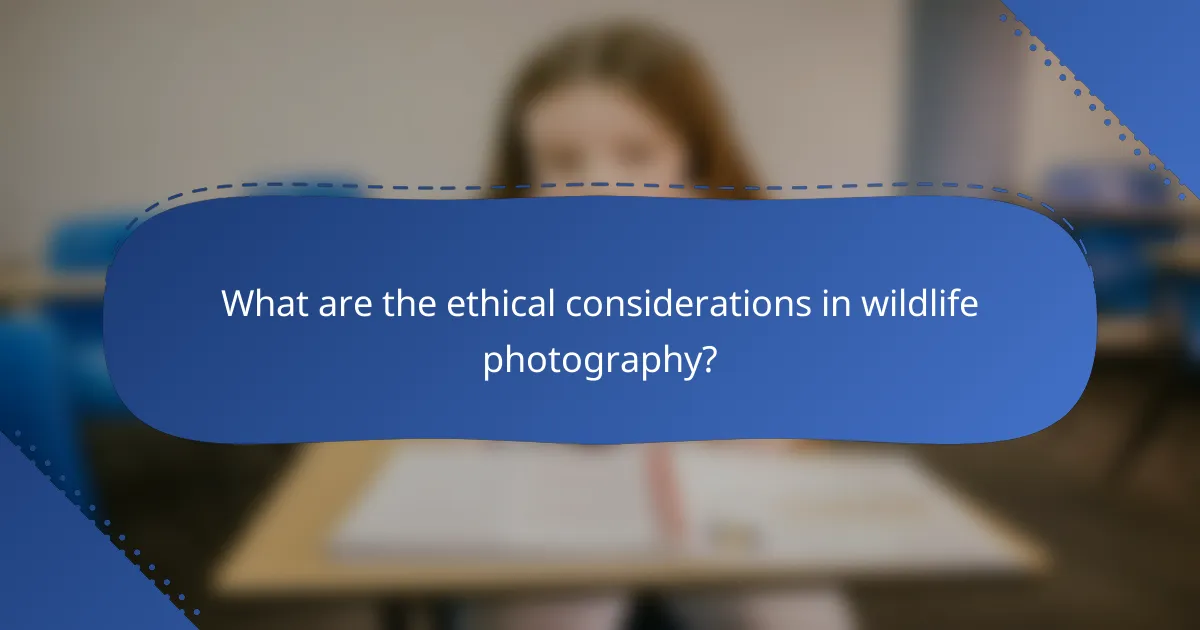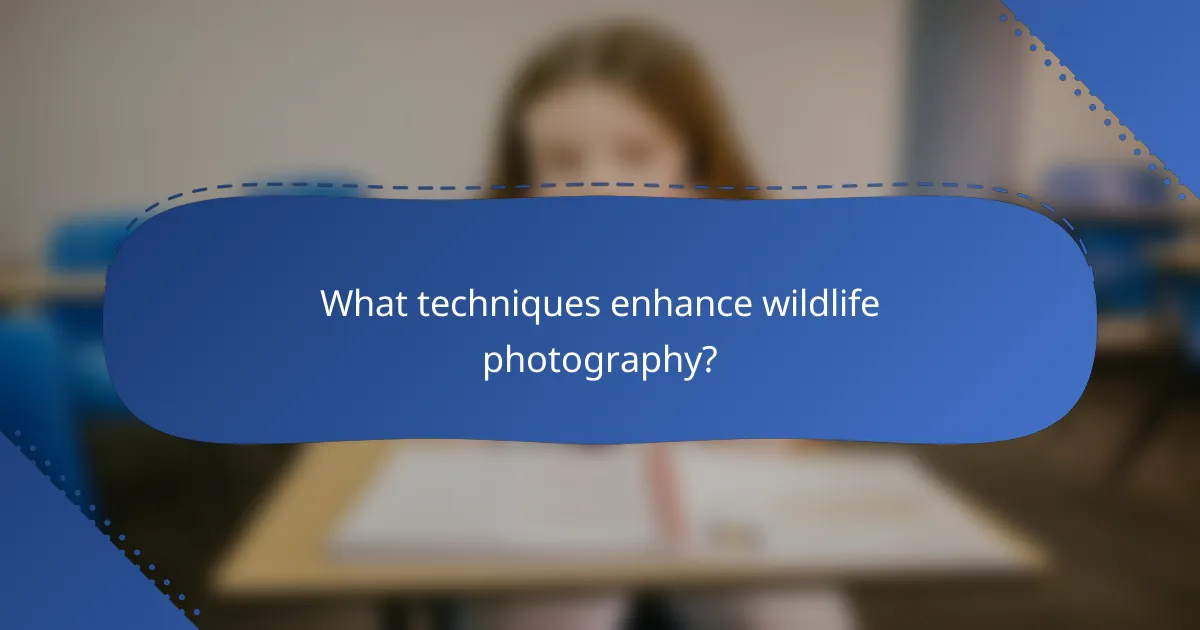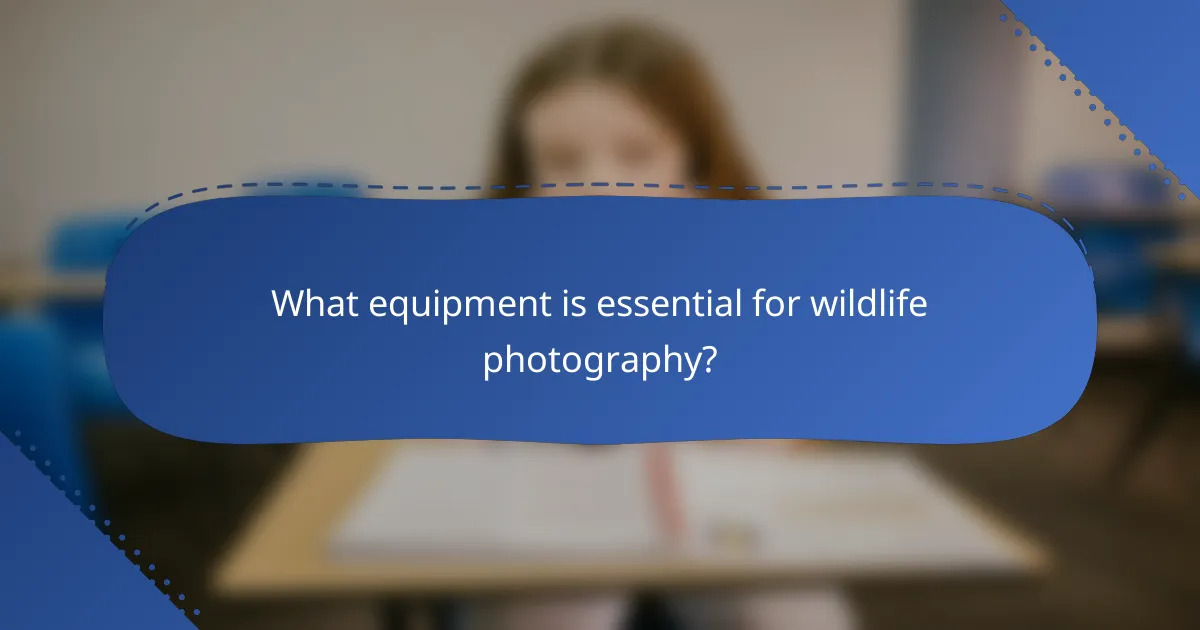Wildlife photography is a captivating art form that requires a deep understanding of ethical considerations, techniques, and equipment. Photographers must prioritize the well-being of animals and their environments while employing strategies to enhance their images. Utilizing the right gear and mastering techniques can lead to stunning photographs that respect and celebrate the beauty of nature.

What are the ethical considerations in wildlife photography?
Ethical considerations in wildlife photography focus on minimizing harm to animals and their habitats while capturing images. Photographers must balance their artistic pursuits with the responsibility to protect wildlife and the environment.
Respect for animal welfare
Respecting animal welfare is paramount in wildlife photography. Photographers should avoid disturbing animals during their natural behaviors, particularly during breeding or nesting seasons. Using long lenses can help maintain distance, reducing stress on wildlife.
Additionally, it’s crucial to recognize signs of distress in animals. If an animal exhibits signs of fear or agitation, it’s best to back away and allow it to return to its natural state.
Impact on natural habitats
The impact of wildlife photography on natural habitats can be significant. Photographers should be mindful of their surroundings and avoid trampling vegetation or disturbing ecosystems. Staying on designated paths and using established viewing areas helps minimize habitat disruption.
Consider the cumulative effects of multiple photographers in a single area. When visiting popular locations, be aware of the potential for overexposure and take steps to mitigate your footprint.
Legal regulations and permits
Legal regulations and permits are essential aspects of ethical wildlife photography. Many national parks and protected areas require specific permits for photography, especially when using professional equipment. Always check local regulations before planning a shoot.
Adhering to these laws not only protects wildlife but also ensures that photographers contribute to conservation efforts. Violating regulations can result in fines and damage to the photographer’s reputation.
Responsible use of technology
Responsible use of technology in wildlife photography includes understanding the tools at your disposal and their potential impact. Drones, for example, can provide unique perspectives but may disturb wildlife if flown too close. Always follow guidelines for drone use in natural areas.
Additionally, using camera traps should be done thoughtfully to avoid invasive monitoring of sensitive species. Ensure that the placement of traps does not interfere with animal behavior or habitats.
Minimizing human interference
Minimizing human interference is crucial for ethical wildlife photography. Photographers should strive to observe animals without altering their natural behaviors. This can be achieved by maintaining a respectful distance and using natural cover to remain inconspicuous.
Planning shoots during off-peak times can also reduce human presence in sensitive areas, allowing for more authentic wildlife interactions. Consider visiting locations during early mornings or late afternoons when animals are most active and human traffic is lower.

What techniques enhance wildlife photography?
Techniques that enhance wildlife photography include understanding animal behavior, using camouflage, optimizing lighting, and applying effective composition strategies. Mastering these elements can significantly improve the quality and impact of wildlife images.
Understanding animal behavior
Grasping animal behavior is crucial for capturing compelling wildlife photographs. Observing patterns in movement, feeding, and social interactions allows photographers to anticipate actions and position themselves accordingly.
Spend time in the field to learn about the species you are photographing. For instance, knowing when animals are most active, such as during dawn or dusk, can lead to better opportunities for stunning shots.
Use of camouflage and concealment
Camouflage and concealment are essential for approaching wildlife without disturbing them. Wearing neutral colors and using natural materials can help you blend into the environment.
Consider using blinds or hides to remain hidden while photographing. This allows for closer shots without alarming the animals, increasing the chances of capturing natural behaviors.
Optimal lighting conditions
Lighting plays a critical role in wildlife photography. The best times for shooting are during the golden hours—shortly after sunrise and before sunset—when the light is soft and warm.
Avoid harsh midday sunlight, which can create unflattering shadows and overexposed highlights. If shooting during these hours, look for shaded areas or use reflectors to soften the light.
Composition and framing strategies
Effective composition and framing can elevate wildlife photographs. Use techniques such as the rule of thirds to create balanced and engaging images, placing the subject off-center for a more dynamic look.
Incorporate elements of the environment to add context and depth. For example, including foreground elements can create layers in your composition, making the image more immersive.

What equipment is essential for wildlife photography?
Essential equipment for wildlife photography includes a high-quality camera, appropriate lenses, and stabilizing gear. These tools help capture sharp, detailed images of animals in their natural habitats.
Camera types for wildlife photography
For wildlife photography, DSLRs and mirrorless cameras are the most popular choices due to their fast autofocus systems and high image quality. Full-frame sensors generally perform better in low light, which is often crucial when photographing animals at dawn or dusk.
Consider cameras with weather-sealing features if you plan to shoot in various outdoor conditions. This durability can protect your equipment from moisture and dust, ensuring reliable performance in the field.
Recommended lenses for different scenarios
Telephoto lenses, typically ranging from 200mm to 600mm, are essential for capturing distant wildlife without disturbing them. A 300mm lens is a good starting point for most wildlife photographers, providing a balance between reach and portability.
For close-up shots, macro lenses can be beneficial, especially for photographing smaller animals or intricate details like feathers and fur. A versatile zoom lens, such as a 70-200mm, can also be useful for various scenarios.
Importance of tripods and stabilizers
Using a tripod or monopod is crucial for stabilizing your camera, especially with heavy telephoto lenses. This equipment helps reduce camera shake, allowing for sharper images, particularly in low-light conditions or when using slower shutter speeds.
Consider investing in a gimbal head for your tripod, which allows for smooth tracking of moving subjects. This setup is particularly advantageous when photographing birds or animals in action.
Accessories like filters and flash
Filters can enhance your wildlife photography by reducing glare and improving color saturation. Polarizing filters are especially useful for minimizing reflections on water surfaces, while neutral density filters can help manage exposure in bright conditions.
External flashes can also be beneficial for filling in shadows or illuminating subjects in low light. However, be cautious when using flash in wildlife photography, as it can startle animals. Always prioritize the comfort of the wildlife you are photographing.

How to choose the right location for wildlife photography?
Choosing the right location for wildlife photography is crucial for capturing stunning images. Consider factors such as the type of wildlife you want to photograph, accessibility, and seasonal patterns to enhance your chances of success.
Popular wildlife reserves in North America
North America is home to numerous wildlife reserves that offer excellent opportunities for photographers. Yellowstone National Park in Wyoming is famous for its diverse wildlife, including bison, elk, and wolves. The Everglades in Florida provides a unique ecosystem where you can capture images of alligators, manatees, and a variety of bird species.
Other notable reserves include Denali National Park in Alaska, known for its stunning landscapes and wildlife like bears and moose, and the Great Smoky Mountains National Park, which hosts a rich variety of flora and fauna. Each location has its own unique charm and species, making them ideal for wildlife photography.
Best times of year for wildlife sightings
The best times for wildlife sightings often depend on the species and their behaviors. Spring and early summer are typically ideal for many animals as they are more active during mating season and raising young. Conversely, fall can be a great time to observe migratory birds and animals preparing for winter.
For instance, in the northern regions, late spring to early summer is perfect for spotting bears emerging from hibernation, while winter can offer unique opportunities to photograph animals against snowy backdrops. Always check local wildlife calendars for specific peak times.
Researching animal migration patterns
Understanding animal migration patterns is essential for successful wildlife photography. Many species migrate seasonally in search of food, breeding grounds, or suitable climates. Researching these patterns can help you plan your trips to coincide with their movements.
Resources such as wildlife databases, local conservation organizations, and online forums can provide insights into migration routes and timings. For example, knowing that certain bird species migrate south in the fall can guide you to the best locations for capturing their journey.

What are the best practices for post-processing wildlife images?
The best practices for post-processing wildlife images involve enhancing the natural beauty of the subject while maintaining authenticity. This includes careful adjustments to exposure, color balance, and sharpness without altering the essence of the wildlife being depicted.
Editing software recommendations
Popular editing software for wildlife photography includes Adobe Lightroom and Photoshop, both of which offer powerful tools for color correction and image enhancement. Alternatives like Capture One and Affinity Photo also provide robust features suitable for wildlife images. Consider using software that supports RAW file formats for maximum editing flexibility.
Techniques for enhancing colors and details
To enhance colors and details in wildlife images, start by adjusting the white balance to reflect the true colors of the scene. Use tools like clarity and vibrance to make the subject pop while avoiding oversaturation. Sharpening details selectively can also help highlight features such as feathers or fur without introducing noise.
Ethical considerations in image manipulation
When manipulating wildlife images, it’s crucial to adhere to ethical standards that prioritize the integrity of the subject. Avoid excessive alterations that misrepresent the animal’s natural behavior or environment. Additionally, consider the impact of your edits on the viewer’s perception of wildlife, promoting a realistic understanding rather than an idealized version.
